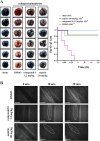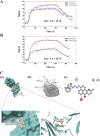A naphthalimide derivative exerts potent antiplatelet and antithrombotic activities without a bleeding tendency
- PMID: 40630131
- PMCID: PMC12234328
- DOI: 10.3389/fphar.2025.1541255
A naphthalimide derivative exerts potent antiplatelet and antithrombotic activities without a bleeding tendency
Abstract
Background: Bleeding is the inherent adverse effect of antiplatelet drugs that has limited their use in the prevention of secondary heart attack and stroke. Thus, finding a novel antiplatelet drug with antithrombotic activities while preserving hemostatic function remains a crucial issue. Here, we screened naphthalimide derivatives that we previously synthesized and identified a novel derivative compound 6, which has a more potent antithrombotic effect and has no effect on bleeding cessation. This study is aimed to determine the antiplatelet mechanism of compound 6 and further test whether compound 6 is a safer and more potent antithrombotic agent.
Methods: Platelet aggregation, flow cytometry and immunoblotting were used to determine the in vitro antiplatelet effect of compound 6. The study of thrombus formation of mesenteric venules in mice was used to evaluate the antithrombotic effect of compound 6.
Results: Compound 6 selectively inhibited collagen-mediated platelet aggregation and markedly prevented thrombus formation without bleeding tendency. Compound 6 also inhibited glycoprotein VI (GPVI) downstream signaling, such as Fyn and Lyn, phospholipase C gamma 2, protein kinase C. Moreover, a surface plasmon resonance assay indicated that compound 6 may directly bind to GPVI, thereby interrupting the interaction of collagen and GPVI. Compound 6 also effectively attenuates collagen-induced granule release, calcium mobilization, and GPIIbIIIa activation.
Conclusion: These findings indicate that compound 6 can selectively inhibit GPVI, eventually suppressing platelet activation and thrombus formation while preserving hemostasis. Compound 6 is a GPVI antagonist and safe antiplatelet agent. Compound 6 also has therapeutic potential for treating cardiovascular diseases.
Keywords: GPVI; antiplatelet agent; naphthalimide derivative; platelet activation; thrombus formation.
Copyright © 2025 Lu, Li, Shih, Chen, Chen, Kao, Liu, Wang, Peng and Lin.
Conflict of interest statement
The authors declare that the research was conducted in the absence of any commercial or financial relationships that could be construed as a potential conflict of interest.
Figures








Similar articles
-
Antithrombotic therapy to prevent cognitive decline in people with small vessel disease on neuroimaging but without dementia.Cochrane Database Syst Rev. 2022 Jul 14;7(7):CD012269. doi: 10.1002/14651858.CD012269.pub2. Cochrane Database Syst Rev. 2022. PMID: 35833913 Free PMC article.
-
WY-14643, a novel antiplatelet and antithrombotic agent targeting the GPIbα receptor.Thromb Res. 2024 Jun;238:41-51. doi: 10.1016/j.thromres.2024.04.011. Epub 2024 Apr 16. Thromb Res. 2024. PMID: 38669962
-
Non-vitamin K antagonist oral anticoagulants (NOACs) after transcatheter aortic valve replacement (TAVR): a network meta-analysis.Cochrane Database Syst Rev. 2025 Feb 24;2(2):CD013745. doi: 10.1002/14651858.CD013745.pub2. Cochrane Database Syst Rev. 2025. PMID: 39991882
-
Antithrombotic treatment after stroke due to intracerebral haemorrhage.Cochrane Database Syst Rev. 2023 Jan 26;1(1):CD012144. doi: 10.1002/14651858.CD012144.pub3. Cochrane Database Syst Rev. 2023. PMID: 36700520 Free PMC article.
-
Antiplatelet and anticoagulant agents for primary prevention of thrombosis in individuals with antiphospholipid antibodies.Cochrane Database Syst Rev. 2018 Jul 13;7(7):CD012534. doi: 10.1002/14651858.CD012534.pub2. Cochrane Database Syst Rev. 2018. PMID: 30004572 Free PMC article.
References
-
- Bellier B., Mccort-Tranchepain I., Ducos B., Danascimento S., Meudal H., Noble F., et al. (1997). Synthesis and biological properties of new constrained CCK-B antagonists: discrimination of two affinity states of the CCK-B receptor on transfected CHO cells. J. Med. Chem. 40, 3947–3956. 10.1021/jm970439a - DOI - PubMed
LinkOut - more resources
Full Text Sources
Miscellaneous

